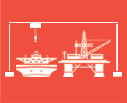Navigation
- Design
- Objectives
- Why AHP?
- Cluster Benefits
- DCO Extension
- Vehicle Storage & Distribution
- River Information
Port Sites
Land Sites
 Interactive Map
Interactive Map
Cluster Benefits
AHP will:
- Dramatically reduce the industry’s expenditure on delivery and installation vessels
- Introduce a new, fixed, transparent charging model for operating the quays. A fixed price charging model provides stability and a huge cost saving when compared to other port costs
- Allow lower delivered costs for components by dramatically reducing the number of supply chain interventions (lifts and moves), reducing the components ‘journey’ and overall industry carbon footprint’
A truly integrated cluster in the Humber will bring additional benefits and have a profound impact on wider business behaviours towards the sector:
- Cost and risk reduction – a higher propensity to finance and insure projects
- An integrated cluster will enable deeper relationships between manufacturers and key suppliers to be enhanced (a subject long since embraced by the oil and gas sector)
- Having a critical mass of activity in one geographic area will accelerate innovation and shorten ‘time to market’
- Installation rates can be accelerated due to an optimal deployment location (long quays, designed to -17m CD) in close proximity to market.
- The quays are designed to receive the largest delivery vessels so that tenants can maximise the use of delivery vessels allowing access to world market shipments and avoid the costs and time delays of inter European split of cargo.
- A cluster will allow manufacturers to have greater control over their quality assurance chain with suppliers adjacent to their own assembly plants. This expedites meetings and minimises time out of the office for senior personnel.
- The large land bank at AHP allows investors to phase investments and stagger growth according to their needs and market share.
- The opportunity to share multi user infrastructure such as SPMT and crawler cranes negates the need for investors to purchase expensive capital equipment.
AHP – COST BENEFITS
The combination of the ‘big space in the right place’ brings cost advantages on a major scale.
“Logistics savings by clustering would be between 2% and 3% of the total turbine sales value compared to distributed supply chains so there is a strong incentive for turbine producers to group their manufacturing facilities, supply chain and construction facilities.”BVG Associates
AHPs effective deployment location combined with the ability for suppliers and OEMs to be located within close proximity to one another eliminate the expensive logistics costs associated with a distributed supply chain.
The table below compares the lifts and moves required in the journey of an offshore wind turbines tower (in three separate sections) from the factory to it being loaded onto an installation vessel at its deployment port (AHP). It compares the merits of a distributed supply chain against a scenario where it is manufactured on and deployed from AHP.
| Lifts / Moves | Over the life of Dogger Bank* | |
|---|---|---|
| Distributed Supply Chain | 24 | 55,536 |
| AHP | 9 | 20,826 |
*denotes – Dogger Bank consisting of 1600 5MW and 714 7MW turbines
This exercise shows that 15 separate interventions (lifts and moves) are eliminated from the journey of each offshore wind turbines tower. As an indication of what that means for the industry it would knock 34,710 lifts and moves out of the overall completion process of Dogger Bank (based on a prediction that 1,600 5MW turbines and 714 7MW turbines are used.) Once this is escalated to include all the other components of a wind turbine it would create a resounding saving, not only in terms of lifts and moves but costs, risks and installation times.
This exercise does not even consider the additional equipment that is involved with these logistics interventions or the additional costs associated with them such as:
- Component Packaging and discarding of waste material
- Insurance premiums
- Damage costs
- Vessel Costs (charter rates, fuel, supplies and labour)
- Ports charges at load out port facility
- Handling fees(stevedoring)
- Storage costs and equipment at both the port and place of manufacture












